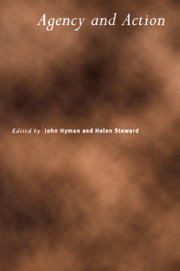Book contents
- Frontmatter
- Contents
- Preface
- Notes on Contributors
- Agency and Actions
- Two Ways of Explaining Actions
- Anscombe on ‘Practical Knowledge’
- Action, the Act Requirement and Criminal Liability
- Emotion, Cognition and Action
- Kantian Autonomy
- The Structure of Orthonomy
- Normativity and the Will
- Can Libertarians Make Promises?
- Intention as Faith
- The Destruction of the World Trade Center and the Law on Event-identity
The Structure of Orthonomy
Published online by Cambridge University Press: 07 September 2010
- Frontmatter
- Contents
- Preface
- Notes on Contributors
- Agency and Actions
- Two Ways of Explaining Actions
- Anscombe on ‘Practical Knowledge’
- Action, the Act Requirement and Criminal Liability
- Emotion, Cognition and Action
- Kantian Autonomy
- The Structure of Orthonomy
- Normativity and the Will
- Can Libertarians Make Promises?
- Intention as Faith
- The Destruction of the World Trade Center and the Law on Event-identity
Summary
According to the standard story of action, a story that can be traced back at least to David Hume (1740), actions are those bodily movements that are caused and rationalized by a pair of mental states: a desire for some end, where ends can be thought of as ways the world could be, and a belief that something the agent can just do, namely, move her body in the way to be explained, has some suitable chance of making the world the relevant way. Bodily movements that occur otherwise aren't actions, they are mere happenings (Davidson 1963, Davidson 1971).
The feature that bodily movements have that makes them especially suitable to count as actions, as distinct from (say) the ends that agents desire, is that they are the events in the world over which agents are supposed to have direct rational control: agents’ abilities bottom out with movements of their bodies (Danto 1963). This is why the occurrence of an action, as distinct from a mere happening, does not depend on whether the agent's bodily movement causes and rationalizes the end she desires. That merely affects whether that which she directly controls, the movement of her body, can be redescribed as the action of intentionally bringing about the desired end (Davidson 1971).
We can therefore sum up the roles of the different elements in this Humean story of action in the following terms. When desires for ends and means-end beliefs combine to cause and rationalize bodily movements in the way required for direct control by an agent—this is what the ‘DC→’ signifies in figure 1—then those bodily movements count as actions of that agent.
- Type
- Chapter
- Information
- Agency and Action , pp. 165 - 194Publisher: Cambridge University PressPrint publication year: 2004
- 13
- Cited by

